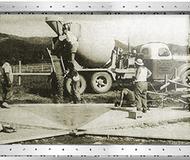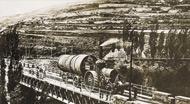History
The story of concrete is closely tied to that of cement, one of its key constituents. It's a story that continues into the present day, as concrete evolves to become the material of a thousand possibilities and a source of constant inspiration for architects.

|
We live in a world of concrete, surrounded by roads, buildings and bridges. While most people think that it's a modern invention, concrete has been around for thousands of years, as has its companion, cement. The words are often used as if they were interchangeable, although they are two distinct substances. Cement is the material used to bind together bricks or stones in the building process. Concrete is a material created by mixing cement with fine pieces of stone, pebble, crushed brick (these pieces are called the aggregate) and sand. A chemical reaction causes the cement to harden around the aggregate and become an extremely hard substance. The oldest known surviving concrete in the world is in the former republic of Yugoslavia, and is believed to have been laid in 5600 BC, using red lime as the cement. As long ago as 3000 BC, the Egyptians were using gypsum as cement to build their pyramids. Mud mixed with straw was used to bind bricks. The Greeks and Cretans used lime mixtures as cement in 800 BC. The Greeks and Romans, Babylonians and Assyrians used cement with concrete as long ago as 300 BC. Lime and bitumen were their primary ingredients, although the Romans also added animal fats, blood and milk to their mixtures. The Romans made many innovations in the use of concrete, including using metal reinforcing bars. Unfortunately, they used bronze which has a different rate of expansion and contraction as concrete, which caused problems in their buildings. However, many of their roads and buildings are still standing today. Much knowledge of concrete and cements was lost during the Dark Ages and the Middle Ages. By the 1600s and 1700s, technology was again advancing and these lost secrets were being rediscovered. In the 1800s several patents were awarded for formulas of cement which were used in concrete. In the mid-1800s, several men discovered the use of iron with concrete. In 1830, a booklet was published which suggested using iron and concrete for a roof. In 1848, Joseph Louis Lambot built a dinghy out of iron rods covered in a fine layer of concrete. In 1849, a French gardener by the name of Joseph Monier built concrete pots reinforced with iron mesh. Unlike the bronze bars used by the Romans, iron bars expand and contract at the same rate as concrete. This opened the way for the construction of high-rise buildings, dams such as the Hoover Dam, and interstate highways. Cities blossomed. Today, even houses are being built of concrete. It is a versatile material, which can be painted, stamped with designs and molded.
|

|
A material comes into its own |
|
|
A French government circular on October 20, 1906 authorized the use of reinforced concrete as a building material. Since 1897, reinforced concrete and its techniques had been part of the curriculum at France's Ecole des Ponts et Chaussées. Future civil engineers who received this training included Eugène Freyssinet, the father of pre-stressed concrete, which was patented in 1929.
|

|
History in motion: constant innovation in concrete |
|
|
The end of the 1980s saw the emergence of high-performance concretes such as ultra-high performance fiber-reinforced concretes self-placing and self-leveling concretes. The history of concrete parallels that of Lafarge. As a research pioneer in this field, Lafarge continues to develop innovations that give free rein to architectural creativity. |

|





